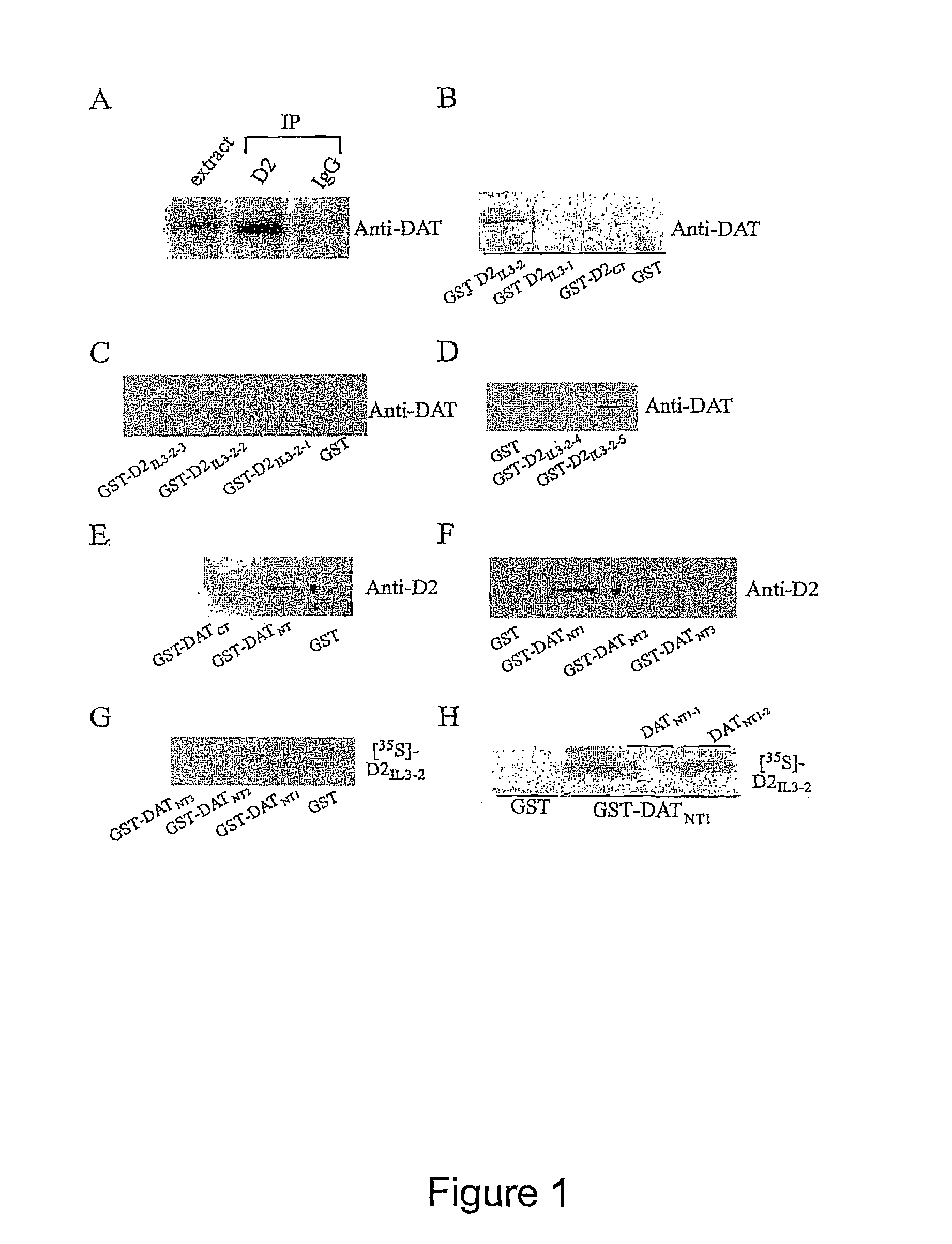Compositions and methods for modulating dopamine neurotransmission
a technology of dopamine neurotransmission and composition, applied in the direction of drug composition, peptide, metabolism disorder, etc., can solve the problems of small molecule compounds, no practical means of modulating dopamine activity, and no dopamine receptor or transporter selectiveness of the described compounds, etc., to achieve significant sensimotor gating deficit, significant spontaneous hyperlocomotion, and reduced dat mediated da
- Summary
- Abstract
- Description
- Claims
- Application Information
AI Technical Summary
Benefits of technology
Problems solved by technology
Method used
Image
Examples
example 1
D2 Receptor Fragments that Bind to DAT from Rat Striatal Tissue
[0098]To determine the existence of D2: DAT complexes, coimmunoprecipitatition of D2 receptor and DAT from rat striatal tissue was determined. As depicted in FIG. 1A, D2 receptor coimmunoprecipitated with DAT suggesting an interaction between the D2 receptor and DAT. The intracellular domains of both the D2 receptor and DAT contain putative consensus sequences for receptor phosphorylation and potential binding sites for various proteins important for signaling [e.g. α-synuclein, GRIP] (14-17). To determine which regions of the D2 and DAT are involved in the formation of D2: DAT complex, various glutathione-S-transferase (GST) fusion proteins, encoding the third intracellular loop (IL3) and the carboxyl tail (CT) of the D2 receptors (GST fused to D2[IL3-1]: K211-K241 (SEQ ID NO:5); GST fused to D2[IL3-2]: E242-Q344 (SEQ ID NO:3); GST fused to D2[CT]: T399-C414 (SEQ ID NO:8); amino acid numbering in accordance with D2 shor...
example 2
DAT Fragments that Bind to D2 Receptor from Rat Striatal Tissue
[0102]To locate the interacting site on DAT in D2-DAT coupling, GST-fusion proteins encoding the amino terminus (NT) and the carboxyl terminus (CT) of DAT were prepared: (GST fused to DAT[NT]:M1-D68 (SEQ ID NO:6); GST fused to DAT[CT]:L583-V620 (SEQ ID NO: 18) were used in affinity purification assay (FIG. 1E). These results reveal that the sequence encoded by the DAT[NT] facilitates the interaction with D2 receptors since only the GST fused DAT[NT] (SEQ ID NO:6), but not GST fused DAT[CT] (SEQ ID NO:18) (or GST alone), was able to ‘pull-down’ D2 receptors. Further experiments show that GST fused DAT[NT1] (M1-P26) (SEQ ID NO:7), but not the GST fused DAT[NT2] (A16-T43) (SEQ ID NO:9) or GST fused DAT[NT3] (K35-D68) (SEQ ID NO: 10), can successfully pull-down D2 receptors from solubilized rat striatum (FIG. 1F).
[0103]Therefore, the DAT[NT1] (M1-P26) (SEQ ID NO:7) region of DAT and D2[IL3-2-5] (I131-Q344) region (SEQ ID NO:...
example 3
Coexpression of D2 Receptor with DAT Upregulates Dopamine (DA) Uptake in HEK-293 Cells
[0107]The DAT is a major determinant of dopaminergic neurotransmission via its key role in terminating synaptic transmission and in regulating the concentration of DA available for binding to multiple post- and pre-synaptic dopamine D1 and D2 like receptors. To investigate the functional relevance of the D2-DAT interaction, changes in DAT activity upon coexpressing D2Short receptors (SEQ ID NO: 19) in HEK-293 cells was assessed. D2Short, instead of D2Long receptor (SEQ ID NO:20), was chosen based on previous studies that have shown that the D2Short receptor is the predominant presynaptic D2 receptor while D2Long is preferentially involved in postsynaptic signaling (18-20). As illustrated in FIG. 2A, the translocation velocity of cellular DAT-mediated DA uptake was significantly increased in HEK-293 cells co-transfected with D2 receptors relative to cells co-transfected with DAT and the mammalian ex...
PUM
 Login to View More
Login to View More Abstract
Description
Claims
Application Information
 Login to View More
Login to View More - R&D
- Intellectual Property
- Life Sciences
- Materials
- Tech Scout
- Unparalleled Data Quality
- Higher Quality Content
- 60% Fewer Hallucinations
Browse by: Latest US Patents, China's latest patents, Technical Efficacy Thesaurus, Application Domain, Technology Topic, Popular Technical Reports.
© 2025 PatSnap. All rights reserved.Legal|Privacy policy|Modern Slavery Act Transparency Statement|Sitemap|About US| Contact US: help@patsnap.com



